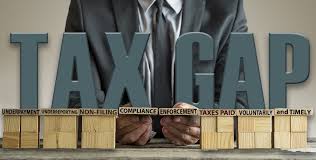Tax Gap in India
- ByAdmin --
- 12 Aug 2024 --
- 0 Comments
Tax Gap in India
- The difference between taxes legally owing and taxes collected is known as the tax gap.
- For many years, there has been an ongoing issue with the tax gap—the discrepancy between the amount of taxes that people should pay and the amount that they actually voluntarily and on time pay.
- The tax gap arises when individuals underreport their tax liabilities on tax returns, underpay taxes owed on filed returns, or neglect to submit a necessary tax return entirely or on time (non filing). These mistakes can be made on purpose or accidentally.
Present state of tax compliance in India:
- The Ministry of Finance's most recent tax statistics release highlights important developments in the country's tax environment.
- From 2023 to 2024, India's net direct tax receipts increased 17.7% to reach Rs. 19.58 lakhs crores.
- Direct Tax: A direct tax is one that a person or organization pays to the body that levied it directly. The fact that those with lower incomes pay less in taxes and vice versa make it a "progressive tax."
- One form of direct tax is income tax, which is determined by an individual's or an organization's earnings.
- The contribution of corporate taxes to total tax collection decreased from 49.6% in 2022–2023 to 46.5%.
- Taxes levied by governments on the earnings of businesses are known as corporate taxes. Usually, after deducting various credits and deductions, a corporation's net income is used to calculate these taxes.
- As of February 2024, the difference between the corporate and personal income tax shares widened even more, with the corporation tax amounting to 26% and the income tax making up 28% of the total tax, a record high.
- The proportion of indirect taxes has grown from 2010 to 2011; these taxes, which include union excise charges and the Goods and Services Tax, are seen as "regressive" as they are paid equally by all consumers, regardless of their income levels.
Legislation relating to direct and indirect tax:
The provisions of The Income Tax Act, 1961 regulate income tax legislation in India.
The GST Act is the body of rules and regulations pertaining to taxes (GST). The Integrated Goods and Services Tax (IGST), the State Goods and Services Tax (SGST), and the Central Goods and Services Tax (CGST) Act are among them. The laws as a whole establish the guidelines for GST compliance.
Causes of the "tax gap" include:
- The comparatively lower level of compliance among those in the informal economy, which is one of the main causes of this "tax gap."
- Simple, equitable, and effective taxes are implemented via a solid revenue system. A tax system that over accommodates the flaws in the tax administration and the operation of a parallel informal economy can have detrimental effects on tax equity,
- the effectiveness of resource allocation, and the integrity of tax revenue collection.
- Tax incentives run the risk of undermining these principles by making the tax system more complex.
- India has a far lower tax to GDP ratio, which has to be improved.
- Resolving the Tax Gap
Sustainable compliance and revenue development can result from a cooperative compliance framework program that fosters mutual confidence and a solid ongoing connection between the tax department and the taxpayer.
The government has taken the following actions to increase direct tax collection:
- Vivad se Vishwas Scheme: Declarations for the resolution of outstanding tax issues are filed under the Vivad se Vishwas scheme.
- Awareness and Education initiatives: To encourage tax compliance and discourage tax evasion, the government runs awareness and education initiatives.
- Emphasis on Digital Transactions: To deter cash-based transactions, which are more difficult to manage for tax purposes, the government is encouraging digital payments.
- pushing for the establishment of global standards for tax gap estimation in order to promote comparability and efficient policy design.
- More funding should be provided to revenue authorities so they can strengthen early detection, promote prevention, and quickly address non-compliance.
Conclusion:
The issue of recurring tax disparities in emerging nations is widely acknowledged, yet it remains unsolvable. Estimating the tax gap becomes a crucial tool for enhancing countries' capacity to collect taxes while also serving as a gauge for how well-funded governments are. It serves as a helpful management tool for the tax administration as well.










0 comments